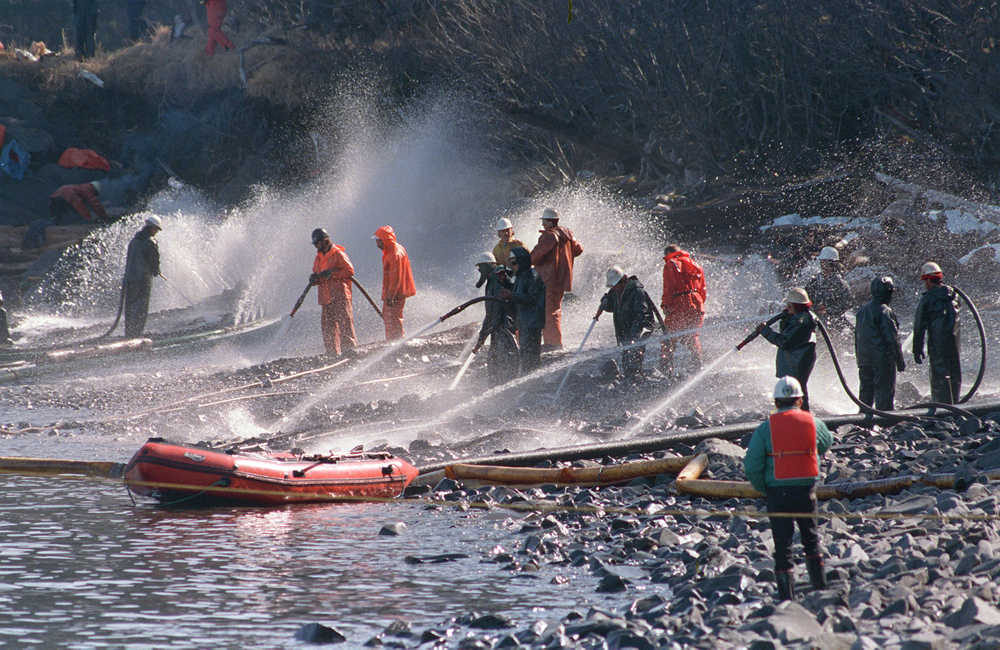ANCHORAGE — Before the Deepwater Horizon oil spill in 2010 in the Gulf of Mexico, there was the Exxon Valdez disaster in Alaska, at the time the nation’s largest oil spill.
The 987-foot tanker, carrying 53 million gallons of crude, struck Bligh Reef at 12:04 a.m. on March 24, 1989. Within hours, it unleashed an estimated 10.8 million gallons of thick, toxic crude oil into the water. Storms and currents then smeared it over 1,300 miles of shoreline.
For a generation of people around the world, the spill was seared into their memories by images of fouled coastline in Prince William Sound, of sea otters, herring and birds soaked in oil, of workers painstakingly washing crude off the rugged beaches.
Twenty five years later, most of the species have recovered, said Robert Spies, a chief science adviser to governments on the oil spill restoration program from 1989 to 2002. But some wildlife, as well as the people who live in the region, are still struggling.
Here’s a look at what’s changed since the spill:
“The bottom fell out of the price of fish,” he said. Pink salmon that sold for 80 cents per pound fell to 8 cents per pound. Consumers turned to farm fish or tuna out of fear of tainted salmon. His boat caught 2.5 million pound of pinks one season and lost money.
Culbertson turned to other fisheries, traveling as far as California. Fishing 12 months a year, his marriage failed. Friends couldn’t repay loans and lost boats or homes. Exxon compensation checks, minus what fishermen earned on spill work, arrived too late for many.
The fisheries today are not the same. “The shrimp are slowly, slowly coming back. The crab aren’t back. The herring aren’t back. The salmon are back in abundance,” he said.
At the time of the spill, complacency among government officials and the oil industry had set in after a dozen years of safe shipments, said Mark Swanson, director of the Prince William Sound Regional Cizens Advisory Council and a former Coast Guard officer.
When the tanker ran aground, for instance, spill response equipment was buried under snow. Alyeska Pipeline Service Co. in 1989 had 13 oil skimmers, five miles of boom and storage capacity for 220,000 gallons of spilled oil.
Now, Alyeska has 108 skimmers, 49 miles of boom and on-water storage capacity of almost 38 million gallons. North Slope oil must be transported in double-hull tankers, which must be escorted by two tugs. Radar monitors the vessel’s position as well as that of icebergs.
The company conducts two major spill drills are conducted each year. And nearly 400 local fishing boat owners are trained to deploy and maintain boom.
After the spill, the population of herring crashed. It is now listed as “not recovering.” The silvery fish is a key species because it is eaten by salmon, seabirds and marine mammals from otters to whales. Four years after the spill, the estimated herring population based on modeling shrunk from 120 metric tons to less than 30 metric tons.
How that happened remains a question, said Scott Pegau, research program manager for the Oil Spill Recovery Institute in Cordova, Alaska.
Here’s what’s known: Adult herring feed on zooplankton, which crashed for three years after the spill. With less to eat, herring may have been more susceptible to disease normally fended off within a herring population.
Herring populations can stabilize at a low or high number, but something has prevented a rebound. Oil likely is no longer a factor, Pegau said.
Responders estimated that as many as 3,000 sea otters died the first year. Hundreds more died in the years after of exposure to oil that persisted in sediment, where otters dig for clams.
Three factors could have had an impact on the otters’ ability to survive. Oiled fur loses insulating value. Otters ingest oil as they groom, and researchers years after the spill found blood chemistry evidence consistent with liver damage. Grooming takes time away from feeding.
“One of the lessons we can take from this is that the chronic effects of oil in the environment can persist for decades,” said Brenda Ballachey, who moved to Alaska a few months after the spill and spent the next summer dissecting sea otter carcasses collected from beaches and frozen.
The U.S. Geological Survey research biologist is the lead author of a federal study released last month that concludes that sea otters have finally returned to pre-spill numbers.

